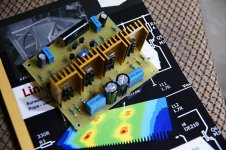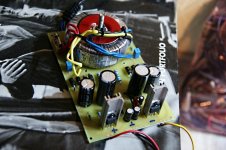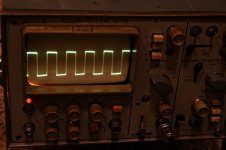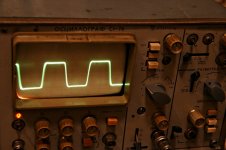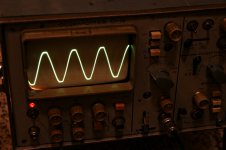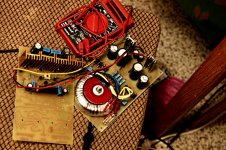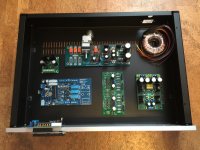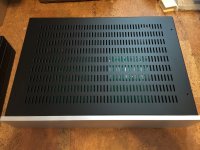Yes it is! Sometimes the things I find on eBay from China baffle me! I usually buy all of my gold-plated audio connectors there for pennies on the dollar for the same ones sold here in the USA that are "rebadged".
FYI - I already have an 18V+18V Antek toroid
In the Blowtorch tread they talk about a JC-2 preamp knockoff for $120 plus shipping $ 30. Crazy.
Sorry for threadjack.
Jan
In the Blowtorch tread they talk about a JC-2 preamp knockoff for $120 plus shipping $ 30. Crazy.
Sorry for threadjack.
Jan
FYI---- later JC added fet follower. That would be the better circuit.... the JC2 could only drive high z loads (100K) with little current for driving long cables (keep to 1m).
-RNM
I notice this amp is very sensitive to changes. I changed out to some nos carbon a while back and it took a while to settle, changed out the 330ohm to Kiwame and it took a little time then to the dual power supply and the new ps needed time but now everything is burning in/settling and the sound is once again cohesive, powerful but realistic bass, with notes, not just bass, and plenty of depth and separation. Very nice.
Has anyone determined the actual output of the amp into different loads? If it has been posted then I either forgot or didn't see it.
Has anyone determined the actual output of the amp into different loads? If it has been posted then I either forgot or didn't see it.
Hello, Lots of good information in this thread 
my Marsh headphone amplifier is under construction - i also integrated DC coupled B1 for volume control in one PCB with optional DC blocking capacitor.
one channel is already soldered , but when I create PCB I made a pretty big mistake - incorrect output transistor pinout(do not believe Google images -Check Data sheets). I use sk170/sj74 + BD outputs. I will re-done PCB again tonight from zero. At least PSU board working fine( 50VA 2x15Vac transformer + linear regulators).
regards,
Oskars
my Marsh headphone amplifier is under construction - i also integrated DC coupled B1 for volume control in one PCB with optional DC blocking capacitor.
one channel is already soldered , but when I create PCB I made a pretty big mistake - incorrect output transistor pinout(do not believe Google images -Check Data sheets). I use sk170/sj74 + BD outputs. I will re-done PCB again tonight from zero. At least PSU board working fine( 50VA 2x15Vac transformer + linear regulators).
regards,
Oskars
Attachments
Post some images when you are done. Looking forward to it.Hello, Lots of good information in this thread
my Marsh headphone amplifier is under construction - i also integrated DC coupled B1 for volume control in one PCB with optional DC blocking capacitor.
one channel is already soldered , but when I create PCB I made a pretty big mistake - incorrect output transistor pinout(do not believe Google images -Check Data sheets). I use sk170/sj74 + BD outputs. I will re-done PCB again tonight from zero. At least PSU board working fine( 50VA 2x15Vac transformer + linear regulators).
regards,
Oskars
ok one channel soldered:
seems that everything works: hum 0.05mV with test wiring.
bias - 100ma per channel.
DC offset less then 1mV
20Khz;
90Khz;
clipping @ 9Vrms @13.8V
one channel soldered
i will measure thd with sound-card tomorrow.
seems that everything works: hum 0.05mV with test wiring.
bias - 100ma per channel.
DC offset less then 1mV
20Khz;
90Khz;
clipping @ 9Vrms @13.8V
one channel soldered
i will measure thd with sound-card tomorrow.
Attachments
Got my preamp chassis in today ... looks like the Marsh HA will fit right in with no problems!
Excellent! So you are building a preamp with a great headphone amp!
Excellent! So you are building a preamp with a great headphone amp!
Yes sir!
The last piece of the puzzle is creating a logic circuit controlled by the headphone jack's switch to switch the power to the CCS-fed shunt reg for the Marsh and also the preamp output to power the Marsh and mute the RCA out when headphones are plugged in.
I look forward to your impressions with the power supply you are using. What caps did you choose?
The PS caps are whatever came on it from China. The inputs are Nichicon, outputs Sanyo.
The Marsh amp has BG's on it.
craigtone,
in your preamp, what are you doing to get the heat out of the headphone amp transistors and the corresponding regulators?
mlloyd1
This is the top cover
Attachments
jamato8 interpreted my question correctly.
actually, i think you WILL need heatsinks for output devices of the marsh headphone amp if you are biasing as in the LA article. MAYBE not if you use 2 diodes instead of three ... MAYBE ...
but why take chances with all that space?

mlloyd1
actually, i think you WILL need heatsinks for output devices of the marsh headphone amp if you are biasing as in the LA article. MAYBE not if you use 2 diodes instead of three ... MAYBE ...
but why take chances with all that space?
mlloyd1
I have mine biased with 2 diodes vs 3 and they most likely wouldn't need sinks but I use them anyway. Better safe than sorry as mlloyd1 says. Another builder of the amp took a temp of the output devices and felt that they don't need sinking but again, no harm with them when biased with 2 diodes. And if you bias with all three diodes, without question then need a good sink.
After a while you might want to look into a Goldpoint attenuator. I prefer it to DACT and they are less expensive. DACT actually copied Goldpoint originally and every time Goldpoint makes a change to improve the controls, DACT does the same. Anyway, the quality of sound improves in the mids and high freq with bass about the same as a good plastic or carbon control.
After a while you might want to look into a Goldpoint attenuator. I prefer it to DACT and they are less expensive. DACT actually copied Goldpoint originally and every time Goldpoint makes a change to improve the controls, DACT does the same. Anyway, the quality of sound improves in the mids and high freq with bass about the same as a good plastic or carbon control.
Last edited:
- Home
- Amplifiers
- Headphone Systems
- Marsh headphone amp from Linear Audio
